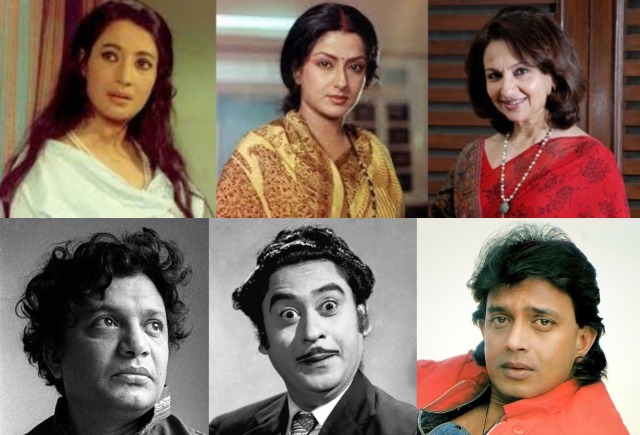The Bombay film industry among the largest in the world has from its beginning been enriched by participation of the country’s best in the trade, from story to script-writing to direction to music to acting. It is only natural that Bengal where creativity gets precedence over wealth generation will have historically a major presence in films made in Bombay, since renamed Mumbai.
So when silent films were made and then through the decades of evolvement to the present times, geniuses and also brave hearts of the kind of Himanshu Rai to Devika Rani (they were a married couple), to Nitin Bose to Bimal Roy to Mukherjee brothers to Ashok Kumar brothers to Sachin Dev Burman to Hemanta Mukherjee to Salil Chowdhury made a mark in the industry in western India, which in course of time gave itself the moniker Bollywood.
If you leave the distinguished Ashok Kumar and Kishor Kumar and in recent times the immensely talented and versatile Mithun Chakraborty, recipient of Dadasaheb Phalke Award, Bengali male actors have been found shy in trying out their luck in Bollywood. Having some hold on the Bengali screen, they don’t want to navigate the uncharted waters of Bollywood for fear of losing of what they have achieved in their home state.
Good looking but not so good in acting Biswajit had a few remarkable successes such as Bees Saal Baad and Kohraa, where he had the good fortune of teaming up with Waheeda Rehman. But as it happens with many in the industry he could not hold on to the success for long. Bollywood or for that matter other film centres across the world are replete with instances of promising careers of both male and female actors going down the tubes for which they themselves have to blame.
Legendary Uttam Kumar, whom Satyajit Ray considered a “star in the true Hollywood sense” and an “instinctive actor” postponed it far too long before he made his debut in Bollywood with a forgettable Chhoti Si Mulaqat. The film bombed leaving Uttam Kumar in financial and mental despair. Perhaps, he would have done better had he accepted the Raj Kapoor offer to act in his film. Raj Kapoor had other major disappointments with two other Bengalis: He could not prevail upon Suchitra Sen to act in his film and then nothing would have made him happier if Ray would be ready to make a film under the RK banner.
ALSO READ: Dada Moni – The Actor Who Could No Wrong
In contrast to the verily indifferent presence of Bengali male actors in Bollywood films, their female counterparts from Suchitra Sen (Devdas, Andhi, Mamta, Bombai Ka Babu and Musafir) to Sharmila Tagore (An Evening in Paris, Anupama, Aradhana, Amar Prem), to Rakhee Gulzar (Jeevan Mrityu, Lal Patthar, Reshma Aur Shera, Sharmeelee) to Moushumi Chatterjee (Zindagi, Aag hi Aag, Agnee, Piku) had had a commanding screen presence over as long as they were doing their work.
Among them all, Suchitra Sen will always remain an enigma, for she would jealously guard her privacy. Suchitra conquered the hearts of millions, especially when she was paired with Uttam Kumar even though she never had much time for film journalists. When she was still in demand, Suchitra in search of inner peace quit acting and became a recluse much to the disappointment of her legions of fans.
Her withdrawal reminded one of German actress Marlene Dietrich, who became increasingly reclusive in her final years, both physically and emotionally. Didn’t iconic Swedish actress Greta Garbo seek a kind of oblivion once she settled down in a New York apartment on retirement from acting? She wrote in a letter: “I am almost always alone. I would often talk to myself.” Suchitra Sen was never lonely in that sense. She had for company her daughter Munmun and two granddaughters.
Fortunately for cine lovers, the three other Bengali actresses – Sharmila, Rakhee and Moushumi – are still engaged in acting in films and people are saluting them for their efforts defying age. Sharmila’s return to the Bengali screen with the just released Puratawn (ancient in English) which deals with mother-daughter relationship, family challenges of adjustment in the face of changing values and problems of ageing, including forgetfulness. Sharmila who plays the role of Mrs Sen the mother has always been as candid as one cane be where she would be unsparing of herself.
This streak of her character was once again in evidence when she told The Telegraph: “Normally, I don’t like myself. I am very critical of myself. I keep finding out faults and saying I could have done better. But in Puratawn, I felt I did okay… I think I have done a good job and convincing job.” Incidentally, she recently had an occasion to see Nayak and “I loved myself there as well.”
Alas, we may not once again see Sharmila doing any more films because of the age factor and heavy demands that film shooting makes on actors. The other day, Sharmila made admission that Puratawn was her swan song in film acting. “You need to be physically fit to shoot a film, and I’m not sure my health will permit that anymore.” Sad that is. But she is leaving behind a rich oeuvre, with the maiden film being Apur Sansar by Satyajit Ray. Sharmila is one actor who with equal ease essayed a role in an art film as in a commercial cinema.

